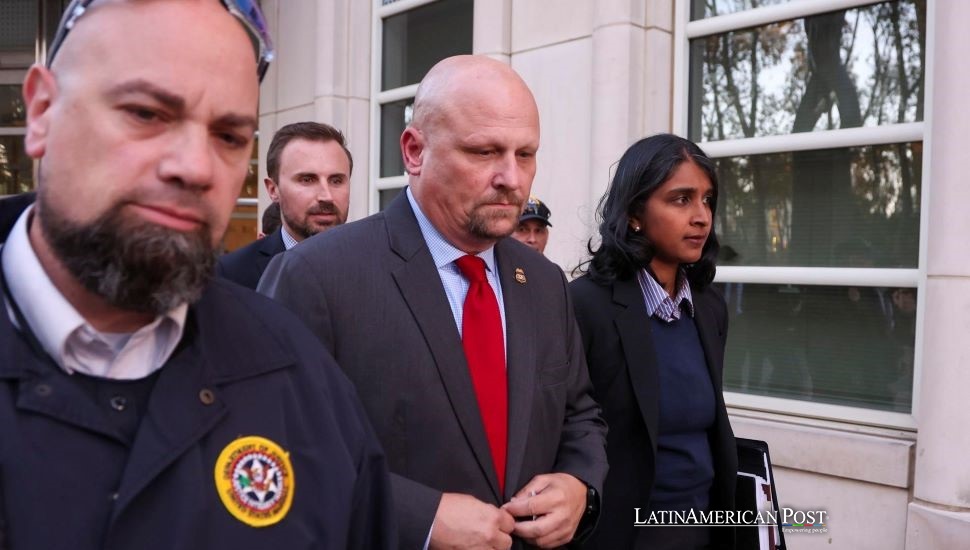Drug Tsar’s Corrupt Legacy Shaping Mexico’s War

Genaro García Luna, once Mexico’s top security official, has been sentenced to more than 38 years in a U.S. prison. His conviction for drug trafficking exposes the deep-rooted corruption in Mexico’s fight against cartels, with ramifications still shaping the country’s violent drug war today.
The Architect of Mexico’s War on Drugs
In a New York courtroom, Genaro García Luna stood motionless as his fate was sealed: 38 years in prison for his involvement with drug cartels. The former Mexican Public Security Secretary, once heralded as the chief architect of Mexico’s war on drugs, fell from grace most spectacularly. His sentence marked the end of a career that had cast him as a vital figure in Mexico’s fight against organized crime, yet his betrayal ran deep.
As the public face of the government’s security strategy under President Felipe Calderón, García Luna was instrumental in ramping up Mexico’s battle against the cartels. However, behind his iron-fisted approach, he was secretly aiding one of Mexico’s most feared criminal organizations, the Sinaloa cartel. His conviction shocked the world, with BBC reports underscoring the extent of his duplicity. “His role in ramping up the war on drugs in Mexico from 2006 to a whole new level can’t be overstated,” drug war expert Falko Ernst told the BBC.
García Luna’s trial revealed a sinister reality: while he led the public charge against drug lords, he was on the payroll of the very criminals he was supposed to eliminate. His fall from power is more than just the story of a corrupt official; it represents the complexities and contradictions at the heart of Mexico’s drug war. García Luna’s case illustrates how deeply entangled the government and cartels became, blurring the lines between law enforcement and criminality.
Corruption and Collusion at the Highest Levels
García Luna’s conviction for accepting bribes from the Sinaloa cartel shocked many, but for those who followed Mexico’s drug war, the signs of his corruption had been apparent for years. “Suspicion always lingered over García Luna,” reported the BBC, with rumors swirling about his ties to organized crime long before any legal action was taken.
As Public Security Secretary, García Luna used his position to direct state resources against the Sinaloa cartel’s rivals, including the brutal Los Zetas cartel. In exchange for his protection, García Luna received millions of dollars in bribes, allowing the Sinaloa cartel to expand its reach across Mexico. His strategy was not unique, as Benjamin T. Smith, a professor at Warwick University, explained to the BBC: “Every public security chief before him did the same thing.”
For García Luna, however, the stakes were higher. The vast sums of money he received, and the degree to which he aided the Sinaloa cartel made him a prime target for investigation. Yet his downfall did not come during his time in office; it came years later when he moved to the United States, seemingly out of the spotlight. The BBC’s coverage of his case raised questions about why it took so long for justice to catch up with him and why the U.S. Drug Enforcement Administration (DEA) allowed him to operate with impunity for so long.
A Strategic Game: Backing One Cartel Over Another
One of the key revelations from García Luna’s trial was his strategic favoring of the Sinaloa cartel over others. The practice of backing one criminal organization to gain leverage over another was not new, but García Luna took it to a new level. By directing government forces against the Sinaloa cartel’s rivals, he allowed the group to consolidate its power, all while receiving millions in kickbacks from drug lord Joaquín “El Chapo” Guzmán.
“You have to choose one over the other because you need informants,” explained Professor Smith to the BBC. “The only way to enter them is to have informants inside. So, you back one crew over another.” This strategy of selective enforcement may have seemed pragmatic in the short term, but in the long run, it only intensified the violence in Mexico.
For Falko Ernst, the corruption exposed by García Luna’s case is emblematic of the broader challenges facing Mexico’s war on drugs. “It shows how this recipe of a supposedly ‘good’ state acting against the bad guys doesn’t square with the realities on the ground in Mexico,” he told the BBC. The complicity between state officials and cartels has created a system where violence flourishes, and ordinary Mexicans bear the brunt of the chaos.
García Luna’s downfall reveals the inherent contradictions in Mexico’s approach to tackling organized crime. On the one hand, the government publicly declared war on the cartels, but behind the scenes, officials like García Luna were profiting from the very criminals they claimed to oppose. The thin line between collusion for public order and outright corruption blurred where García Luna’s actions became indistinguishable from those of the cartels he worked with.
The Lasting Impact of García Luna’s Actions
The legacy of García Luna’s time in office continues to shape Mexico’s drug war. His strategy of favoring one cartel while attacking others fueled a wave of violence that is still playing out across the country. The current power struggle within the Sinaloa cartel, which has led to a surge in killings in recent months, can be traced back to García Luna’s decisions while in office.
As investigative journalist Deborah Bonello pointed out to the BBC, García Luna’s conviction comes too late to reverse the damage he did. “García Luna left office in 2012, and the damage he did is already done,” she said. “His conviction isn’t going to change anything. So it feels a bit like ‘too little, too late.’” Indeed, the current violence within the Sinaloa cartel, which has seen rival factions vie for control, is partly a result of the power dynamics García Luna helped create.
His conviction may offer a symbolic victory in the fight against corruption, but it raises more significant questions about the effectiveness of Mexico’s security policies. As Bonello pointed out to the BBC, the U.S. recently arrested one of the Sinaloa cartel’s co-founders, Ismael “El Mayo” Zambada, without sharing any intelligence with their Mexican counterparts. “They bypassed the Mexicans because of the corruption within law enforcement,” she noted. The distrust between Mexican and U.S. authorities is a direct consequence of years of collusion between government officials and cartels.
For President Claudia Sheinbaum, the fallout from García Luna’s actions presents one of her first significant challenges. As violence escalates in states like Sinaloa, her administration will need to find new ways to combat organized crime without repeating the mistakes of the past. But as Falko Ernst told the BBC, García Luna’s approach left a lasting mark on Mexico’s criminal landscape. “His strategy was fuel on the fire of conflict,” Ernst said. “It led to the extreme splintering of the criminal landscape, which is much more aggressive towards civil society and the legal economy.”
The splintering of criminal groups, coupled with García Luna’s corrupt legacy, has made Mexico’s drug war more complex and dangerous than ever. As more minor factions fight for control, the violence becomes increasingly indiscriminate, affecting not just rival cartels but ordinary Mexicans caught in the crossfire. García Luna’s conviction may be a step towards accountability, but the road to justice and peace in Mexico remains long and fraught with challenges.
Also Read: Columbus’ Fortunate Voyage: The Narrow Escape from Hurricanes
In the end, Genaro García Luna’s conviction is a stark reminder of the deep-seated corruption that has plagued Mexico’s war on drugs. While his sentencing may bring a sense of closure, the damage he wrought continues to haunt the country. As Mexico grapples with the legacy of his actions, the fight for justice and transparency in the battle against organized crime is far from over.




